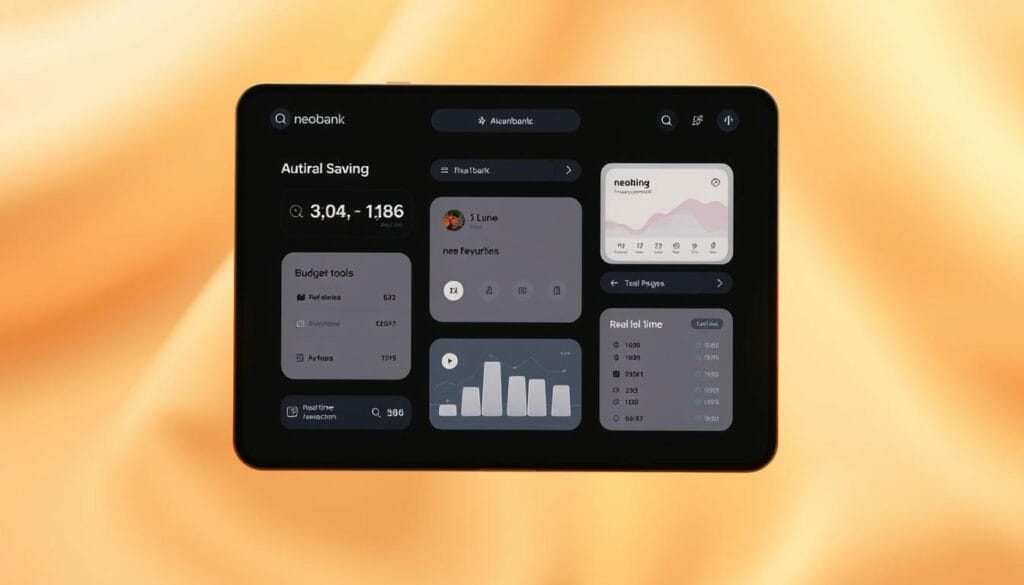Did you know that over 60% of Americans struggle to meet their financial goals due to poor saving habits? As we approach 2025, innovative tools are transforming how people manage their money. These solutions combine AI optimization and behavioral finance principles to help users save smarter.
When selecting the right tool, security is a top priority. Look for platforms with FDIC insurance and advanced encryption standards. Integration with traditional banking systems ensures seamless transactions, while adaptive saving algorithms tailor strategies to individual needs.
Emerging trends like neobank partnerships and hybrid saving-investment platforms are reshaping the landscape. These advancements offer users more flexibility and growth potential. Explore how these tools can help you achieve your financial goals with ease.
This article dives into eight app categories, analyzing their technical specifications and use cases. Whether you’re saving for a rainy day or planning long-term investments, these tools can make a significant difference. Discover the future of financial management here.
Key Takeaways
- Over 60% of Americans face challenges in meeting their financial goals.
- AI-driven tools are revolutionizing how people save money.
- Security features like FDIC insurance and encryption are essential.
- Integration with traditional banking ensures smooth transactions.
- Adaptive algorithms personalize saving strategies for users.
- Neobank partnerships and hybrid platforms are emerging trends.
- Eight app categories are analyzed for their unique benefits.
Why Automated Savings Apps Are a Game-Changer

Managing finances can be overwhelming, but automation simplifies the process. By analyzing spending patterns through Open Banking APIs, these tools make micro-saving decisions effortless. Studies show that 73% of users report increased consistency in meeting their savings goals with automation.
How Automation Removes the Stress of Saving
The “set-and-forget” approach reduces decision fatigue, a principle rooted in behavioral economics. Instead of manually tracking every expense, users can rely on algorithms to handle their budget. For example, round-up features save 23% more compared to manual transfers. This feature ensures that even small amounts add up over time.
The Power of Small, Consistent Contributions
Consistency is key to achieving financial success. By saving just $5 daily, users can accumulate over $18,250 in 10 years with a 4% annual percentage yield. Automation ensures these contributions happen without requiring constant attention. It’s a simple yet effective way to make the most of your time and resources.
Top Automated Savings Apps to Transform Your Finances

Innovative platforms are leveraging advanced technology to help users achieve their financial goals. These tools combine machine learning, behavioral insights, and seamless integration with traditional banking systems to create personalized saving strategies.
Oportun: AI-Powered Savings With Overdraft Protection
Oportun uses machine learning to analyze cash flow and predict spending patterns. This allows users to set savings goals without worrying about overdrafts. The platform is FDIC-insured through partner banks, ensuring security for your bank account. At $5 per month post-trial, it’s an affordable option for those looking to save smarter.
Qapital: Rule-Based Savings With Visual Goal Tracking
Qapital’s unique approach lets users create rules for saving. For example, the “Guilty Pleasure Rule” reduces discretionary spending by 41%. This method helps users stay focused on their savings accounts while tracking progress visually. With tiered pricing from $3 to $12, it offers flexibility for different budgets.
Acorns: Invest Spare Change Effortlessly
Acorns simplifies investing by rounding up purchases made with credit cards or debit cards. The Mighty Oak Debit Card enables real-time round-up investing, making it easy to invest spare change. With a 3% APY checking account and 4.52% savings via Lincoln Savings Bank, Acorns combines saving and investing in one platform.
“Consistency is the key to financial success. Small, automated contributions can lead to significant growth over time.”
These platforms not only simplify saving but also enhance security with 256-bit encryption and biometric authentication. Whether you’re saving for short-term needs or long-term goals, these tools offer tailored solutions. Explore more here to find the right fit for your financial journey.
Budgeting Apps That Automate Your Savings

Effective budgeting is the cornerstone of financial stability, and modern tools make it easier than ever. These platforms help users allocate their income efficiently while automating savings processes. With seamless integration into accounts, they provide a hassle-free way to manage personal finance.
Goodbudget: Digital Envelope System for Hands-On Savers
Goodbudget uses a digital envelope system to help users allocate funds to specific categories. This method is ideal for those who prefer hands-on control over their budget. With multi-device sync capabilities, households can manage finances collaboratively. The premium version costs $10 per month, offering advanced features for serious savers.
You Need a Budget (YNAB): Zero-Based Budgeting With Savings Focus
YNAB follows a zero-based budgeting approach, ensuring every dollar has a purpose. Its four-rule philosophy emphasizes giving every dollar a job, embracing flexibility, and preparing for unexpected expenses. On average, users save $6,000 in their first year. The platform integrates with over 12,000 financial institutions, making it a versatile tool for managing accounts.
Both Goodbudget and YNAB demonstrate how technology can simplify budgeting. Whether you prefer the envelope system or zero-based methods, these platforms offer tailored solutions for your financial needs. For more insights on optimizing your finances, explore low-fee robo-advisors.
Neobanks With Built-In Automated Savings Tools

Neobanks are redefining how people manage their finances with innovative tools. These digital-first platforms combine advanced technology with user-friendly features to simplify saving and spending. Unlike traditional bank systems, neobanks operate on cloud-native cores, offering faster and more flexible services.
Chime: Early Payday and Round-Up Features
Chime stands out with its early payday feature, allowing users to access their cash up to two days sooner. This is made possible through direct deposit acceleration mechanics. Additionally, Chime’s round-up feature automatically saves spare change from every card transaction, helping users build their savings effortlessly.
With a 0.50% APY savings account, Chime ensures your money grows over time. The platform also emphasizes security with real-time transaction monitoring, protecting users from fraud. These features make Chime a reliable choice for modern savers.
Current: Savings Pods With Interest-Earning Potential
Current introduces a unique savings structure with its “pods.” These isolated savings buckets allow users to organize their funds while earning individual APY. Each pod has a $2,000 interest cap, making it ideal for targeted saving goals.
Current’s architecture ensures flexibility and growth potential. Users can allocate funds to specific pods, such as emergency funds or vacation savings, and watch their money grow. This approach combines the benefits of a traditional bank with the innovation of a neobank.
Neobanks now hold 12% of US transaction accounts, reflecting their growing popularity. Their cloud-native infrastructure and advanced fraud prevention systems make them a secure and efficient choice for managing finances. Explore how these platforms can transform your financial habits today.
Apps That Help You Save and Invest

Combining saving and investing has never been easier with modern financial tools. These platforms leverage advanced technology to simplify the process, helping users grow their wealth effortlessly. Whether you’re looking to reduce expenses or earn rewards, these apps offer tailored solutions for your financial goals.
Rocket Money: Subscription Cancellation and Bill Negotiation
Rocket Money is a dual-purpose platform that focuses on expense reduction and automated saving. It helps users cancel unused subscriptions and negotiate bills, saving an average of 35-60% on recurring expenses. This dual-path architecture ensures users not only save money but also optimize their spending habits.
By analyzing spending patterns, Rocket Money identifies areas for improvement. Its automated saving feature ensures consistent contributions to your investment goals. This combination of expense reduction and saving makes it a powerful tool for financial growth.
Upside: Cash-Back Rewards Converted to Savings
Upside takes a unique approach by converting cash-back rewards into savings. Its geolocation-based offer engine provides an average of 11% cashback on purchases at partner stores. Users can then transfer these earnings directly into their savings or investment accounts.
This strategy not only boosts savings but also encourages mindful spending. Upside’s platform integrates seamlessly with credit and debit cards, making it easy to earn rewards on everyday transactions. Over time, these small contributions can lead to significant financial growth.
“Combining cashback with automation increases savings rates by 23%, making it a smart strategy for long-term financial success.”
Both Rocket Money and Upside demonstrate how technology can simplify saving and investing. By leveraging these tools, users can achieve their financial goals with minimal effort. Explore these platforms to find the right fit for your needs.
How Safe Are Automated Savings Apps?

Security is a critical factor when choosing financial tools, especially those that handle your money directly. Users need assurance that their bank account and personal information are protected from potential threats. This section explores the key safety measures implemented by these platforms.
FDIC Insurance and Partner Bank Protections
One of the primary safeguards is FDIC insurance, which protects deposits up to $250,000 per account. Many platforms partner with FDIC-insured banks to ensure users’ funds are secure. In the UK, the Financial Services Compensation Scheme (FSCS) offers similar protection, covering up to £85,000 per person, per financial institution.
Partner banks often hold funds in ring-fenced accounts, ensuring they are separate from the platform’s operational funds. This structure provides an additional layer of security, minimizing risks even in the event of a platform’s financial instability.
Encryption and Data Security Measures
Advanced encryption standards, such as AES-256, are used to protect sensitive data. This level of encryption is considered unbreakable with current technology, even against quantum computing threats. Platforms also comply with PSD2 regulations, which mandate secure data sharing and user authentication.
Incident response protocols are another critical component. Many platforms adhere to 72-hour breach notification mandates, ensuring users are promptly informed of any potential risks. Additionally, user authentication has evolved from traditional 2FA to behavioral biometrics, further enhancing security.
For more insights into how these platforms ensure safety, explore automated savings apps and their regulatory frameworks.
Choosing the Right App for Your Financial Goals

Selecting the right financial tool requires understanding your unique needs and goals. With so many options available, it’s essential to evaluate how each platform aligns with your saving style and long-term objectives. This ensures you maximize the benefits while minimizing unnecessary costs.
Matching App Features to Your Savings Style
Different users have different saving habits. Passive savers may prefer tools that automate contributions, while active savers might enjoy platforms offering hands-on control. For example, Acorns’ round-up feature is ideal for those who want to save without constant monitoring.
On the other hand, Qapital’s rule-based system appeals to users who want to customize their saving strategies. Understanding your saving style helps you choose a platform that complements your financial habits and goals.
Comparing Fees and Membership Tiers
Fees can significantly impact your overall savings. Platforms like Acorns offer tiered pricing ranging from $3 to $9 per month, while Qapital’s plans vary between $3 and $12. It’s crucial to analyze these costs against the features provided.
Consider the total cost of ownership, including potential overdraft fees or additional charges. Many platforms offer free trials, allowing you to test their features before committing. This ensures you select a tool that fits your budget and financial goals.
“Choosing the right platform involves balancing cost, functionality, and personal preferences to achieve your financial objectives.”
Additionally, check for API ecosystem compatibility and institution migration protocols. These factors ensure seamless integration with your existing accounts and minimize disruptions during transitions. For more insights on optimizing your financial journey, explore our blog.
Maximizing Your Savings With Automation
Achieving financial success requires a strategic approach, and automation can amplify your efforts. By leveraging tools that align with your savings goals, you can optimize your financial growth over time. This section explores how to set realistic objectives and pair them with high-performing accounts.
Setting Realistic Savings Goals
Implementing the SMART goal framework ensures your objectives are Specific, Measurable, Achievable, Relevant, and Time-bound. For example, saving $5,000 for an emergency fund within a year is a clear and actionable target. Platforms like Chip automate contributions based on your cash flow, helping you stay on track.
HYSA laddering strategies further enhance your savings. By automating transfers into multiple high-yield accounts, you can maximize interest rates while maintaining liquidity. This approach is particularly effective for long-term financial planning.
Pairing Apps With High-Yield Accounts
High-yield savings accounts (HYSAs) offer significantly higher returns compared to traditional accounts. For instance, Chip provides a 4.76% APY via ClearBank, while Monzo offers a 3.6% base rate. Automating deposits into these accounts ensures your money grows consistently.
Rate chasing automation tools can further optimize your returns. These tools monitor interest rates across platforms and automatically shift funds to the best-performing accounts. This strategy helps you stay ahead of inflation and maximize your earnings.
“Automating your savings and investing strategies ensures consistent growth, even during volatile economic times.”
By combining SMART goals with high-yield accounts and automation, you can achieve your financial objectives efficiently. Explore these tools to take control of your financial future today.
Common Pitfalls to Avoid With Savings Apps
While technology enhances saving strategies, users must remain vigilant about hidden pitfalls. Even the most advanced tools can lead to financial setbacks if not used carefully. Understanding these risks ensures a smoother and more secure experience.
Overdraft Risks and How to Prevent Them
One of the most common issues is overdraft risks. Platforms like Oportun use algorithms to predict spending patterns and prevent overdrafts, but timing vulnerabilities in ACH transfers can still pose challenges. To avoid fees, users should monitor their accounts closely and set up alerts for low balances.
Additionally, some platforms disclaim responsibility for overdraft fees caused by their services. For example, Digit and Albert explicitly state this in their terms. Users should review these disclaimers to understand their financial liabilities.
Understanding Hidden Fees
Hidden fees can erode your savings over time. Subscription creep in tiered services is a common issue. Apps like Trim and Truebill charge for services such as bill negotiation, which may not be immediately apparent. Always review the fee structure before committing to a platform.
Dormancy fees and balance minimum requirements are other areas to watch. Some platforms charge fees if your account remains inactive or falls below a certain threshold. For more insights, explore the hidden risks of online savings tools.
“Awareness of potential pitfalls ensures you maximize the benefits of financial tools while minimizing risks.”
Dispute resolution policies are another critical factor. Many platforms include arbitration clauses, barring court actions. Understanding these terms helps users navigate potential issues effectively. By staying informed, you can make smarter financial decisions and avoid unnecessary costs.
Conclusion
As financial technology evolves, 2025 brings transformative trends in money management. Emerging technologies like blockchain-based protocols are reshaping how users approach savings, offering enhanced security and transparency. Regulatory frameworks are also adapting, fostering stronger fintech-bank partnerships to ensure compliance and user protection.
To achieve your financial goals, it’s essential to adopt a personalized roadmap. Start by evaluating your current habits and identifying areas for improvement. Next, leverage advanced tools that align with your objectives, such as platforms offering automated contributions or high-yield accounts. Finally, monitor your progress regularly to stay on track.
For those seeking to maximize their savings, consider exploring robo-advisor performance reviews to find the best returns. By combining these strategies, you can navigate the evolving financial landscape with confidence and achieve long-term success.
FAQ
How do these tools help manage finances effectively?
Are these platforms secure for storing personal and financial data?
Can I use these tools to invest spare change?
What should I consider when choosing a platform?
How do round-up features work?
FAQ
How do these tools help manage finances effectively?
These tools simplify budgeting by tracking spending, setting goals, and automating contributions. They provide insights into financial habits, making it easier to save consistently.
Are these platforms secure for storing personal and financial data?
Yes, most platforms use encryption and partner with FDIC-insured banks to ensure data security and protect funds. Always verify the app’s security features before use.
Can I use these tools to invest spare change?
Absolutely. Apps like Acorns allow users to invest small amounts from everyday purchases, making investing accessible even with limited funds.
What should I consider when choosing a platform?
Look for features that align with your financial goals, such as budgeting tools, investment options, or high-yield accounts. Compare fees and membership tiers to find the best fit.
How do round-up features work?
Round-up features automatically save the difference from purchases to the nearest dollar. For example, a .50 coffee purchase would round up to , with
FAQ
How do these tools help manage finances effectively?
These tools simplify budgeting by tracking spending, setting goals, and automating contributions. They provide insights into financial habits, making it easier to save consistently.
Are these platforms secure for storing personal and financial data?
Yes, most platforms use encryption and partner with FDIC-insured banks to ensure data security and protect funds. Always verify the app’s security features before use.
Can I use these tools to invest spare change?
Absolutely. Apps like Acorns allow users to invest small amounts from everyday purchases, making investing accessible even with limited funds.
What should I consider when choosing a platform?
Look for features that align with your financial goals, such as budgeting tools, investment options, or high-yield accounts. Compare fees and membership tiers to find the best fit.
How do round-up features work?
Round-up features automatically save the difference from purchases to the nearest dollar. For example, a $3.50 coffee purchase would round up to $4, with $0.50 going into savings.
Are there risks associated with these tools?
Potential risks include overdraft fees if linked accounts have low balances and hidden fees for premium features. Always monitor transactions and understand the app’s terms.
Can these tools help with debt reduction?
Yes, some platforms offer features like bill negotiation or subscription cancellation, which can free up funds to pay down debt faster.
Do these platforms offer high-yield savings options?
Many neobanks and apps provide high-yield accounts or savings pods, allowing users to earn interest on their funds while keeping them accessible.
.50 going into savings.
Are there risks associated with these tools?
Potential risks include overdraft fees if linked accounts have low balances and hidden fees for premium features. Always monitor transactions and understand the app’s terms.
Can these tools help with debt reduction?
Yes, some platforms offer features like bill negotiation or subscription cancellation, which can free up funds to pay down debt faster.
Do these platforms offer high-yield savings options?
Many neobanks and apps provide high-yield accounts or savings pods, allowing users to earn interest on their funds while keeping them accessible.

